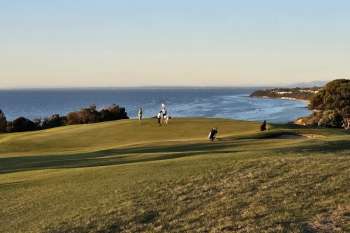Room for Improvement
How do we improve our ranking?
It’s about the most commonly asked question of our Top 100 golf course panel. The answer, sadly, is rarely simple.
There are a number of reasons why golf clubs drop down, or off, our list, and any number of ways for them to rectify the slide and get back where they feel they belong. The safest way for clubs to improve their ranking, is for the focus of any course works to be on making their golf holes better, and not necessarily harder.
Across Australia in recent years there has been an extraordinary amount of money and effort spent trying to make existing golf courses longer and more difficult for elite players. Even clubs with boundary issues and a lack of space have seemed pre-occupied with ensuring their layouts provide a stern test. The argument for such alteration is always that technology has made the game easier and players bomb the ball longer than ever before. While true, the average handicap in Australia, for both men and women, has actually increased over the last 10 years. For most of us the game is getting harder. It’s also taking longer to play.
At the same time as many of our courses are getting longer and more difficult, the way Australians consume their golf is changing. Fewer people are electing to become members of a private club, with more settling on a social game every now and then. For the first time in my memory, some of our most prestigious private clubs are without long waiting lists. Surely decision makers can see the link here, that for many golfers it’s harder to justifying the expense of a private club membership when the golf course beats you up each week.
Recently I visited a Top 100 golf course that had fallen noticeable in each of our previous two rankings. In the club’s view the drop seemed unwarranted. In discussing changes made since the slide began, it became clear that every single alteration - be it a new back tee, a tighter green or a redesigned par four - was intended to make the course play harder. The club claimed that it was simply strengthening a few ‘weaker’ holes, but what I saw was a fixation on difficulty that had robbed the holes of fun for the ordinary member. I wasn’t surprised to learn that the club’s once years long waiting list had evaporated.
Because technological developments in our game have widened the gap between elite players and the average amateur, it has become more difficult to strike the right balance between member enjoyment and championship relevance. Some golf clubs and course operators are clearly stuck here and rather than wasting money trying to fix what might not even be broken, perhaps it’s worth looking for new solutions.
Shorter not longer…
Prior to making any changes to your golf course, it’s important to determine precisely who the changes are being made for, and why. It may seem illogical, but if the aim were to provide a proper test of good players whilst remaining fun for the members then shortening your course, rather than lengthening it, might actually make sense.
Consider this statistic. Prior to the start of the FedEx Cup playoff series in August, the Top 10 golfers this year on the US PGA Tour (according to scoring averages) were all OVER par on the par 3s. That group includes the likes of Rory McIlroy, Tiger Woods, Luke Donald, Adam Scott and Bubba Watson. Each plays the par five holes at least 5 strokes under par per tournament but the one-shotters cause them problems. On these raw stats alone, it seems a better way to make your course harder for the good players would be to add a par three rather than to extend a par four or five. For courses with a lack of space this seems an even more appropriate solution.
Not only are par threes the most difficult holes for the professionals, designed properly they can also be the most enjoyable for the amateurs. In every sense shorter holes are more democratic than longer ones. There is less of an advantage given to power hitters and the cunning high handicapper can use chase-in areas that good players don’t even consider.
Changing your par…
Of course adding a par three might not make sense at your golf club, especially if the board or committee are of the view that 72 is a golf course’s ideal par. This mindset is especially prevalent in Asia, but also here in Australia where only 3 of our Top 25 courses are non-conforming. Those three include Barnbougle Dunes and Royal Melbourne East, each with a par 71 made up of 4 par threes and 3 par fives. The other course is Barwon Heads, which has perhaps the ideal modern configuration of a par 70 made up of 5 one-shotters and 3 longer holes. If you had a blank canvas and wanted to build a course that was fun for members but tough for professionals surely this is how you would do it, by taking away a scoring hole and adding a fun little par three.
Of course Barwon Heads has a lot more going for it than an unconventional par. Many of the individual holes are great fun, and when the wind is blowing its 5,826-metre layout is all the test you could ever want. In many ways it’s the perfect course to hold up as an example of where those clubs obsessed with difficulty have gone wrong.
Harder or more fun?
Recently I asked 30 or so members of our Top 100 ranking panel to tell me what they thought were the three ‘hardest’ golf courses in Australia. Not surprisingly, none selected Barwon Heads. The most popular choices were the Open Course at Moonah Links (12 votes) and Brookwater (11), which featured in the responses of around a third of our panel. Next hardest were National Old on 8 votes, Sanctuary Cove Pines on 7, Hamilton Island, Ellerston and The Australian all on 5 and Magenta Shores, Kennedy Bay, Royal Adelaide and National Moonah on 4. There were also several who nominated Barnbougle Dunes and New South Wales, although mostly with the qualification that they were only tough when the wind was blowing.
After judges responded to my initial question, I asked them what they regarded as our ‘most fun’ courses to play. Deliberately vague, the aim was for the respondents themselves to determine what was or wasn’t fun. As expected, there was a lot of love for Barwon Heads (5 votes) as well as for a great range of regional gems like Port Fairy, Portsea, The Dunes, Moonah Links Legends and Narooma (each with 2 votes).
Barnbougle Dunes with 10 votes was by far the most popular response, however, followed by Royal Melbourne West, New South Wales, National Old and Barwon Heads all on 5 votes. Then came Joondalup, Bonville and Lost Farm on 4, and Kingston Heath and Healesville on 3. The only courses to be nominated as both fun and hard were Barnbougle Dunes, New South Wales, Royal Melbourne West, Ellerston, National Old and National Moonah. Interestingly, each of these courses is ranked among the Top 12 in the country. None of the other Top 12 courses received a single nomination in the ‘hard’ category.
Clearly in the eyes of our panel, the elite courses in Australia are either fun and hard or just plain fun. Clubs considering change, therefore, shouldn’t expect any sort of bounce in their ranking if they ignore the very simple fact that difficult courses are not necessarily great ones.
More than ever, golf clubs in this country need to find a suitable balance between layouts that challenge the better players but remain fun and playable for the average amateur. One of the simplest ways of achieving this is by manipulating your par. This year on the US PGA Tour alone there were a dozen tournaments held on courses with a par of 71, and thirteen on courses with a par of 70. As we know, many of these courses play as 72 for the members and the scorecard is simply amended during tournament week.
The modern professional is used to facing less par fives so converting fives to fours for tournament play would only upset those horrified at the prospect of good players shooting in the low 60s on their home course. Sadly this mindset is damaging for golf, as protecting holes from the strong, accomplished player is likely to leave them unduly taxing on the mere mortal.
While the retention of championship status is important to many, it shouldn’t come at the expense of a sustainable membership. The problem we have in Australia is that often committees value the opinion of the club champion above those of the lesser skilled member. This is a nonsense when you consider the views of some of these better players, and also the fact that many leading course designers, now and throughout history, have been mid-to-high handicappers. There are no ‘hard and fast’ rules in golf course design, except the, ‘just because you hit a decent ball, doesn’t mean you can design a decent hole’ rule.
For golf clubs looking to keep pace with the modern game, it’s important to remember that knee jerk adjustments to a low score or a scorching drive are unlikely to improve a Top 100 ranking nor make a layout more enjoyable for the 95 per cent of members who don’t play off 5 or lower. Those keen to retain such members, let alone attract new ones, would be well advised to focus on improving ‘poor’ holes, rather than strengthening ‘weak’ ones.
Darius Oliver, Architecture Editor
Back to NewsMore News
Report reveals golf's $3.3 billion contribution to Australia
AGIC report reveals total annual benefits to the Australian community, economy and environment from golf.
Cape Wickham Links – The Inside Design Story
Co-designer Darius Oliver reveals the truth behind the design of Australia’s premier modern golf course
Min Woo Lee signs up for Aussie PGA title defence
Reigning champion locks in the defence of his title at Royal Queensland Golf Club in November
Have your say on the future of Moore Park Golf
Golfers unite – another one of our cherished public access golf courses is under threat




